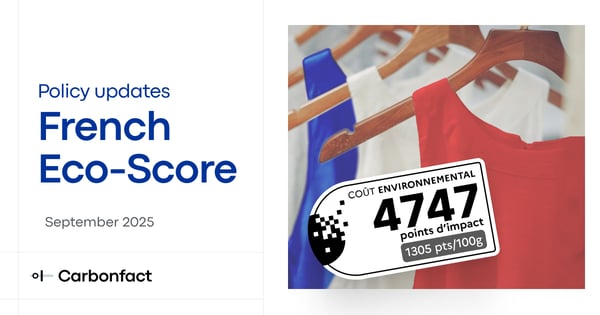In the face of escalating climate change, the fashion industry finds itself at a crossroads, confronted with both the urgency to act and the vast potential for cutting CO2 emissions. According to McKinsey's Fashion on Climate report, in order for the fashion industry to align with the 1.5C threshold set by the Paris Climate Agreement, we need to step up our efforts in the next decade, cutting emissions in half, to approximately 1.1 billion tons by 2030. This sounds hard. But not impossible.
This two-part blog series is a case for optimism. We can decarbonize the fashion industry. We can and we should do it fast. This will require the industry to accelerate abatement actions, including scaling up and intensifying current decarbonization approaches. In this post, we'll outline a few ideas on how we can achieve this ambitious goal. In Part #2, we'll take a deep dive into the brand-supplier relationship and how cutting emissions is a cost-effective business decision. The fashion industry emits ~2 billion tons of CO2e yearly. The task is daunting. So let’s get to work.
Decarbonization levers
In McKinsey's Fashion on Climate report, accelerated abatement is characterized as the effort required to move the industry from 2.7 billion tons of emissions under the no-further-action baseline to 1.1 billion tons in 2030. Accelerated abatement is achievable through many of the same levers that are currently being used to cut emissions, but on an expanded scale or with a higher level of adoption.
.png?width=822&height=577&name=Banner%20blog%20(2).png) Reference: https://www.mckinsey.com/~/media/mckinsey/industries/retail/our%20insights/fashion%20on%20climate/fashion-on-climate-full-report.pdf
Reference: https://www.mckinsey.com/~/media/mckinsey/industries/retail/our%20insights/fashion%20on%20climate/fashion-on-climate-full-report.pdf
Here is an overview of the identified strategies and industry-specific examples:
Raw material production
This lever aims to minimize the environmental impact of materials in the fashion industry. It involves enhancing the sustainability of key materials like cotton, polyester, and viscose through improved production methods. Additionally, it strives to achieve decarbonization by optimizing the mix of materials, incorporating preferred alternatives, and introducing innovative, environmentally responsible materials.
These brands are already making progress with improved material production and sourcing:
Columbia Sportswear: Increased the percentage of recycled polyester for all product divisions from 14% in 2020 to an impressive 48% in 2022. (Source: Columbia Sustainability report )
Lane-Eight: Utilizes sustainably sourced sugarcane, processed into pellets with renewable power, to create a foam that reduces reliance on fossil fuel-derived products while maintaining high-performance shoe materials. (Source: Lane-Eight Sustainability report )
Allbirds: Transitioned from virgin nylon to recycled nylon in their wool styles, acknowledging the need for sustainable alternatives without compromising on durability. In 2022, renewable materials contributed to a reduction of -0.25 kg CO2e, as part of their overall per unit reduction of -1.64 kg CO2e. (Source: Allbirds Sustainability report )
Material preparation and processing
Here, two strategies are important. In 2020, the fashion industry was the third largest source of water degradation and land usage. There are two strategies we can take to improve the industry's environmental impact during material preparation. First, this lever involves improving the energy efficiency and environmental impact of material processing through cleaner energy sources and efficient methods. Second, it aims to reduce waste generated during material preparation and processing to lower environmental impact and enhance sustainability.
FILA: Exploring the adoption of Drydye technology to reduce water usage in fabric dyeing. Drydye eliminates the need for water and chemicals in the dyeing process, significantly reducing water consumption and chemical effluents. It also eliminates the drying step after dyeing, cutting energy consumption by more than 50%. This sustainable approach reflects FILA's commitment to reducing its environmental impact in the fashion industry. (Source: Fila Sustainability report )
Product manufacturing
Achieving decarbonization within garment manufacturing by making improvements in the energy mix and efficiency across various manufacturing countries is crucial here. This entails adopting cleaner energy sources and enhancing overall energy efficiency in production processes. Secondly, this lever focuses on minimizing manufacturing waste, aiming to reduce the amount generated during the manufacturing stages.
On Running: On Running's product team uses data to track and reduce pre-production waste, such as optimizing pattern efficiency and production samples. They also work with manufacturers to address post-production waste related to cutting processes. In 2022, they conducted two waste pilot projects, gaining insights into regulatory and recycling challenges in Vietnam. A manufacturing partner of On Running aims for 100% diversion from landfill by 2024, aligning with the brand’s circularity vision. (Source: On Running Sustainability report )
Nike: Before 2020, Nike improved efficiency by replacing coal-fired steam boilers with electric heating, reducing energy consumption by 10% per pair of footwear manufactured between 2015 and 2020. By the end of fiscal year 2021, Nike eliminated coal use in supplier operations for both footwear and apparel manufacturing, promoting sustainability and environmental responsibility. (Source: Nike Sustainability report )
Transportation
Fashion’s complex and lengthy supply chain leads to high carbon emissions during transportation. Promoting the increased use of sustainable transportation methods—including enhancements in the fuel mix, energy efficient fleets, and operational improvements across the supply chain—can dramatically reduce CO2 emissions It also focuses on improving packaging throughout the entire fashion production process, from manufacturing to retail. This improvement entails adopting a more carbon-friendly material mix and reducing overall packaging usage to reduce the environmental impact associated with transportation and packaging practices.
New Balance: Uses paper-based packaging for most of their footwear, including cardboard shoeboxes, recycled tissue paper for protection, and recycled materials for in-line shoeboxes. (Source: New Balance Sustainability report)
Allbirds: Increased their reliance on ocean shipping, achieving 84% in 2021 and an impressive 96% in 2022. (Source: Allbirds Sustainability report )
On Running: Collaborates with Forto, a sea freight and supply chain solutions provider, to transport products using biofuel-powered methods. They employ a book and claim system, simplifying emissions reduction and promoting sustainability in sea freight, particularly in the early stages of the maritime biofuel market. This approach paves the way for increased biofuel availability as more companies adopt similar practices. (Source: On Running Sustainability report )
Operations
The Operations lever in fashion industry decarbonization comprises three strategies: decarbonized retail operations (improving energy efficiency), reduced overproduction (minimizing waste from unsold stock), and minimized returns (limiting environmental impact from returns) to reduce carbon emissions and waste.
PUMA: Achieved a significant climate milestone by sourcing 100% renewable electricity for all its entities since 2020. This move reduced Scope 2 emissions (market-based) significantly, further aided by the closure of Russian stores that heavily relied on heating derived from fossil fuels. PUMA's headquarters, the largest district heat consumer, uses co-generation with electricity and over 50% biogas, resulting in a remarkable 98% reduction in Scope 2 emissions since 2017. (Source: PUMA Sustainability report )
Usage: washing and drying
This lever focuses on reducing the environmental impact associated with the laundering of clothing. Brands can better educate their customers and advocate for washing frequency and improved care practices, such as selecting lower washing temperatures.
Fusalp: Ensures customers receive personalized and easily accessible care instructions, whether they visit their stores or use their online platform. (Source: Fusalp Sustainability report )
New business models
The fast fashion business model has led to overconsumption, overproduction, and high levels of textile waste. New business models can serve as an alternative for consumers, allowing them to stay up-to-date with current trends while reducing waste. This involves adopting innovative approaches, including promoting rental models such as subscriptions or one-time rentals, introducing refurbished/upcycled products, encouraging second-hand sales, and offering product repair services. These strategies aim to reshape the fashion industry toward more sustainable and circular practices.
Nothing New: Nothing New encourages customers to send back their old sneakers, regardless of their condition. These sneakers are sorted at their warehouse, and depending on their condition, they are either donated to charity or disassembled to reintroduce materials into the supply chain. In return, customers receive a $20 store credit. (Source: Nothing New Sustainability report)
Lane Eight: Lane Eight extends the life of shoes by donating lightly worn pairs to charity. These donations support communities and reduce waste. They have made shoe donations to various organizations, including Shoes That Fit, The Watts Empowerment Center, Genesis Women's Shelter and Support, and Run HK. These initiatives exemplify how new business models can contribute to fashion sustainability. (Source: Lane Eight Sustainability report)
End of life: recycling and collection
As it stands, barely 1% of used textiles are recycled into new apparel, so there is huge growth potential with this lever. Increasing the recycling and collection of fashion items to minimize their disposal through incineration without recovery or in landfills not only reduces carbon emissions but cuts costs as well. One report estimates the industry loses USD 100 billion per year by failing to recycle and reuse textiles.
New Balance: 3,590 pairs of shoes were given a new lease on life in 2022 through the shoe repair program at New Balance Japan (Source: New Balance Sustainability report)
PUMA: RE:JERSEY project in Europe recycles worn or unsellable polyester items, including those with expired licenses, into new textiles using innovative chemical recycling. Partnering with football teams like Manchester United and AC Milan, the brand collects used products at fan shops and PUMA stores to be sorted and recycled into new football jerseys. (Source: PUMA Sustainability report)
All of the levers above can be grouped into three categories, each holding a different accelerated abatement potential - upstream operations (60% potential), the brand’s own operations (20%), and sustainable consumer behaviors (20%).
.png?width=679&height=629&name=Banner%20blog%20(3).png) Reference: https://www.mckinsey.com/~/media/mckinsey/industries/retail/our%20insights/fashion%20on%20climate/fashion-on-climate-full-report.pdf
Reference: https://www.mckinsey.com/~/media/mckinsey/industries/retail/our%20insights/fashion%20on%20climate/fashion-on-climate-full-report.pdf
Where should brands focus?
In the fashion and apparel industry, on average, 96% of emissions stem from Scope 3 across brands with approved science-based targets (SBTs). This means that decarbonizing the supply chain (factories, farms, etc.) should be the priority in the context of accelerated abatement supported by investments by brands, updating technology, and focusing on improvements in the energy mix.
Carbonfact’s thought leader Martin Daniel emphasizes: "Most of the impact of fashion brands stems from their material and manufacturing suppliers. They need to engage and support them in their decarbonization journey. It's a win-win for everyone and the right thing to do”. According to Martin, there are four main ways to approach decarbonization of the supply chain:
Reducing the production of goods
This one is simple - the fewer brands produce, the smaller their environmental footprint. Around 30 percent of all clothes made around the world are never sold, according to the Australian Circular Textile Association (ACTA) and the cost of this inventory distortion is estimated by IHL Group in 210 billion US dollars.
Simulating future collections to ensure the most sustainable outcome becomes crucial. Tools like Carbonfact’s Product Impact Simulator empower design and production teams to make informed choices by constructing detailed what-if scenarios directly from a specific product. Whether you want to experiment with different materials, swap components, alter suppliers, country of origin, or alternate transportation methods, its comprehensive design allows you to play with a variety of parameters and immediately see the resulting impact on your emissions.
Transitioning factories towards renewable energy
Before the incorporation of cutting-edge technologies, a substantial reduction in emissions can be achieved by introducing efficiency improvements. This is low-hanging fruit that can be easily attained by replacing outdated, inefficient, poorly calibrated, or inadequately maintained machinery. Updating factory management practices can also minimize unnecessary downtime, ramp-ups, and machine stoppages, which contribute to unnecessary energy expenditure.
More complex initiatives could look like:
- Promoting Carbon-Neutral Energy Procurement: To encourage energy companies to invest in low-carbon energy generation, individual fashion brands or even entire sectors can promote the commitment to exclusively purchasing carbon-neutral energy.
- Relocating Manufacturing for Green Energy Access: Because a majority of textile manufacturing occurs in countries that are still heavily reliant on fossil fuels, brands can relocate their operations to regions with better access to renewable energy or electricity generation using a lower CO2 emissions intensity. Although this is not currently a top priority within the industry, the prospect of such relocations may gain traction if regulations linking textile product carbon and environmental footprints to substantially increased taxation, duties, EPR (Extended Producer Responsibility) fees, and related measures come into effect.
- Water-Efficient Processes and Technologies: Transitioning to processes that require less water or are entirely devoid of water and solvents typically results in energy savings. Technologies such as digital printing, potentially combined with water-efficient fixation methods and other emerging digital finishing techniques, hold promise for reducing energy footprints. Additionally, improving practices like spraying, coating, plasma, or sol-gel processes also contribute to this goal.
- Local Energy Generation: Allocating investments into smaller-scale energy generation capacity at the local level can also help reduce a brand’s carbon footprint during manufacturing. This could be achieved by installing PV modules on factory rooftops or nearby open areas, implementing local onshore wind power generation, or even establishing modest-scale hydroelectric power plants, is a viable strategy. This approach is particularly relevant for textile factories often situated near rivers to fulfill their water requirements.
What does this look like in practice?
NIKE: Since 2019, Nike has offered onsite solar PV consulting to suppliers in key markets. In FY22, suppliers contracted 96 MW of new onsite solar, totaling 190 MW across 64 facilities. This reduced Nike’s manufacturing emissions by 16,400 metric tons of CO2e in FY22. Rooftop solar capacity in Vietnam, Greater China, and Thailand increased by 69% from FY21 to FY22 (source: Nike Sustainability report)
ASICS: aim for a 63% reduction in Scope 3 CO2 emissions by 2030. Their Green Procurement Policy guides these efforts, with a focus on engaging and supporting suppliers in sustainability initiatives. Results include energy-saving partnerships, Clean By Design program participation, and a 3.1% reduction in CO2 emissions from the supply chain compared to 2015. (source: ASICS Sustainability report)
We will talk more about specific ways brands can help suppliers switch to renewable energy in the next series of this blog!
More sustainable transportation of goods
The transport sector is one of the largest contributors to GHG (greenhouse gas) emissions, requiring measures such as reducing air transportation as well as collaboration with vendors to shift towards low-carbon fuels. In our next blog post, we will dive into calculations to see that switching to sustainable transport is actually profitable for the brands.
Nike: In North America, Nike achieved a 10% year-over-year reduction in digital outbound air freight usage for delivering products from distribution centers to online consumers. These accomplishments were the result of cross-functional initiatives carried out by Nike, including improvements in order fulfillment, expansion of regional service centers, the introduction of a sustainable "No Rush" shipping option, and the discontinuation of the free two-day shipping upgrade program. Collectively, these Nike-led initiatives led to a noteworthy 23% reduction in CO2 equivalent emissions per unit for purchases made through nike.com in North America during the fiscal year 2022. (Source: Nike Sustainability report)
Move away from fossil fuel-based materials
Phasing out fossil fuels includes cutting the usage of oil-based plastics like polyester which are over half of the current fibers used in the industry, fueling fast fashion. Polyester's appeal extends beyond its affordability; it's versatile and everywhere. Every year, roughly 700 million barrels of oil are converted into plastic pellets, melted, and extruded into fine filaments that can be spun into synthetic yarns like polyester, according to a BoF analysis of International Energy Agency data.
While it seems that plastic-based materials are deeply entrenched within the industry, there is a significant number of rising alternatives. For example, in 2022 New Balance sourced 44% recycled polyester, while in 2023 PUMA has replaced all polyethylene bags for consumer use with paper bags or durable multi-use bags for sale in their owned and operated stores.
The UN report on Identifying Low Carbon Sources of Cotton and Polyester Fibres shows that the mechanical recycling of PET (polyester) sourced from post-consumer bottles has the potential to achieve substantial GHG emission reductions. That includes a 66% reduction for recycled chips/pellets and a 27% reduction for DTY (Draw Textured Yarn) compared to virgin PET chips and filament DTY. When it comes to chemically recycled PET, it has the capacity to achieve GHG reductions ranging from 5% to 27% by transitioning from virgin PET to chemically recycled PET, contingent on the feedstock source and the region of PET production. However, all of this is possible only through the acceleration of improvements in recycling infrastructure.
How can Carbonfact help your brand to decarbonize?
Carbonfact is the only fashion-specific Carbon Accounting and Product-LCA platform that helps brands and manufacturers discover the exact sources of their environmental impact and take actionable steps to reduce their footprint.
With the Carbonfact tool, you can run detailed and accurate life cycle assessments (LCAs) in a fraction of the time and cost of traditional methods. Our Product Impact Simulation tool enables you to run what-if scenarios on a product level, where you can experiment with different components, suppliers, or transportation methods, and discover the decarbonization strategy for your brand.
Book a 1:1 demo with a member of the Carbonfact team to find out more.







 Martin Daniel
Martin Daniel

 Lidia Lüttin
Lidia Lüttin
